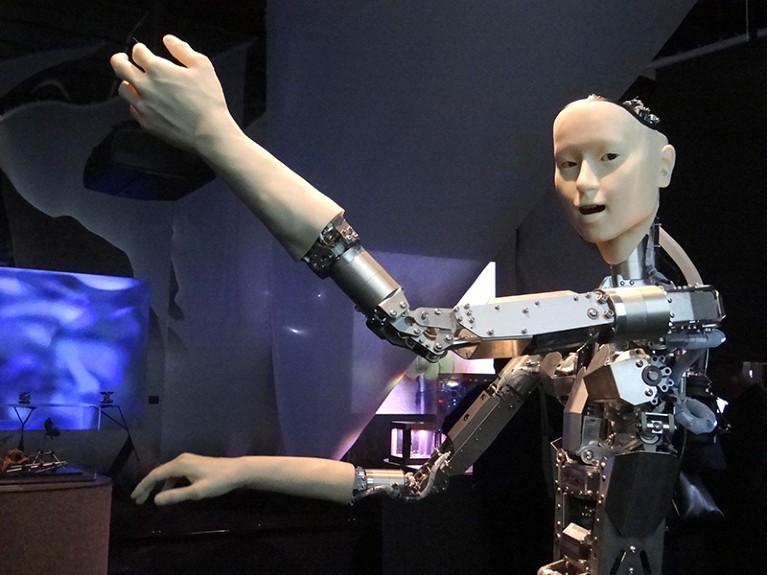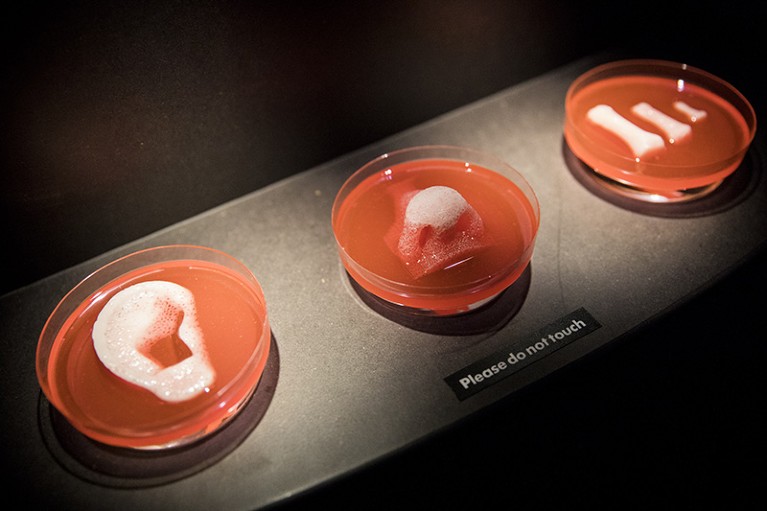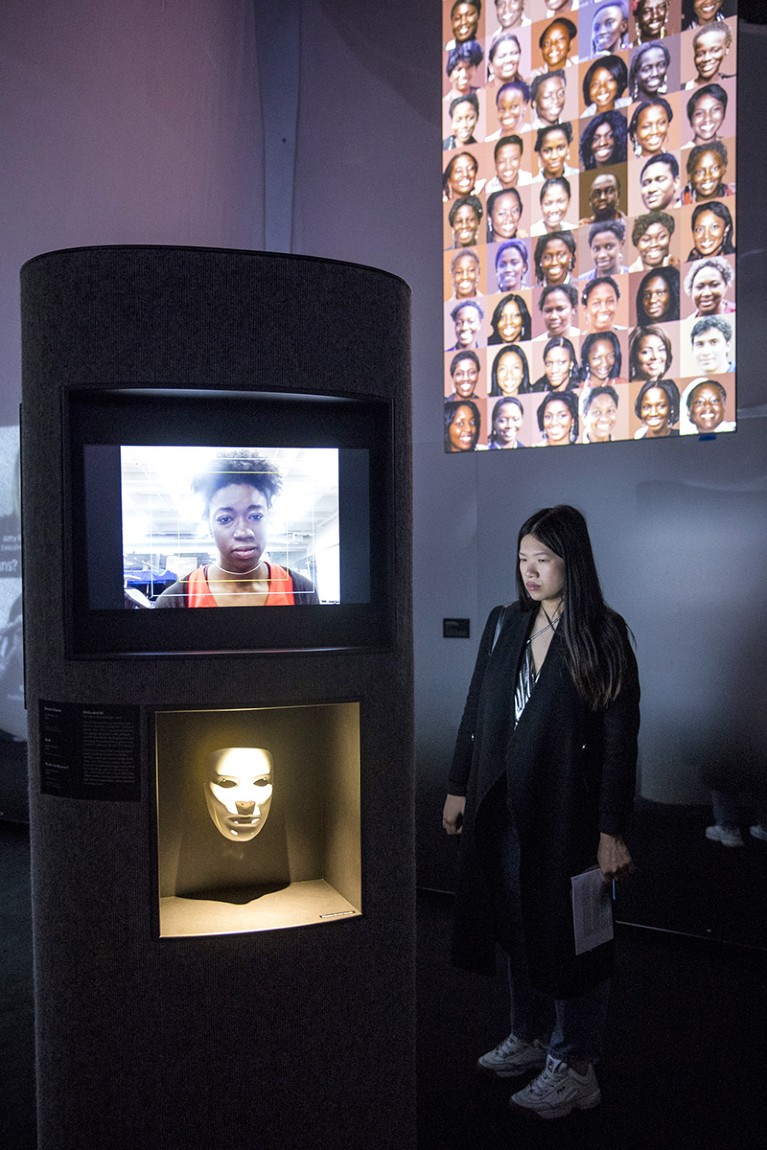
The robot Alter 3 was developed by researchers at Osaka University and the University of Tokyo in Japan.Credit: Nastia M/Alamy
AI: More than Human Barbican Centre, London. Until 26 August 2019.
Artificial intelligence is all around us — a fact deftly captured by the new blockbuster exhibition at London’s Barbican Centre. Visitors to AI: More than Human are bombarded with algorithmic musical compositions, AI-created art swimming on massive screens, facial-expression interactives and a creepy-as-hell robot with a human face and hands.
The multi-pronged programme has taken over the entire arts centre. The flagship exhibition at its heart sets out to examine humanity’s fascination with AI as a way to understand and extend our intelligence. It mixes artwork inspired or enabled by AI, explorations of research projects and historical artefacts. And although not every exhibit hit the mark, I left impressed by the show’s boldness and breadth.
It begins much earlier in history than I’d expected, with an exploration of centuries-old ideas about new kinds of life. These range from golems (lumps of clay brought to life in Jewish folklore) to the fascination of nineteenth-century gothic novelists such as Mary Shelley with the not-quite-human. This relatively traditional, museum-like section is nearly overpowered by the enticingly glitzy sections ahead.
A comprehensive timeline of computing and AI history is next, with plenty for buffs to explore. This includes many unsung (often female) heroes such as Kathleen Booth, who researched some of the first algorithmic neural networks at Birkbeck College, London, in the 1950s. It reminds us, too, that every few decades AI has a heyday, followed by a ‘winter’ in which the hype withers. Among the thoughtfully curated artefacts is the podium from which IBM’s Watson computer system won a 2011 episode of US television game show Jeopardy!. Helped along by a smooth narrative and lucid explanations, this section is absorbing.
A particular gem for a science journalist was the 1951 correspondence between British mathematician Alan Turing and a newspaperman who hoped to see Turing’s Automatic Computing Engine, or “electronic brain”, pitted against humans at chess. (Turing replied that no such thing was yet possible. He referred the reporter to his paper ‘Digital Computers Applied to Games’, later published in the 1953 edited volume Faster Than Thought.)
Soon comes the buzz of today’s AI. Here are the brain-inspired neural networks behind DeepMind’s program AlphaGo, which in 2016 beat a leading player of the strategy game Go. And here is Sony’s adorable US$3,000 robot ‘companion’ puppy, Aibo. (Petting it was delightful, despite its apparent determination to walk into a wall.) Anna Ridler’s 2018 artwork Myriad (Tulips) is a powerful reminder of the human hand behind machine learning: Ridler manually categorized 10,000 photos of tulips. In another work, she taught a neural network to generate a video of a flower, using the labelled data.
With a dive into AI’s ubiquity in society, the interactivity and ambition ramp up. Some of these crowd-pleasing exhibits didn’t land for me. Facial-recognition technology used to track emotions while visitors play a driving game is fun; less clear is the challenge for researchers, or how this translates (or doesn’t) to safer roads. An artwork inviting the visitor to make music with AI created a din I didn’t know how to stop (I retreated in haste).
Organ scaffolds produced by 3D printing at the Wake Forest Institute for Regenerative Medicine in Winston–Salem, North Carolina.Credit: Tristan Fewings/Getty for Barbican Centre
Things get weirder at the end, with a future-facing exploration of artificial life and what it will mean for us. AI-optimized mini-farms sit next to 3D-printed ears and noses, part-engineered from human cells, and a synthetic beehive. Most impressive, if mystifying, is a life-sized robot called Alter 3. Its human-like face and hands part-sheath an exposed metal mechanical body. I watched a television reporter nearly leap out of his skin when Alter 3’s hand brushed his shoulder: a perfect demonstration of the ‘uncanny valley’, the unease we feel with the not-quite-right humanness of androids. A particularly thoughtful exposition of how digital technologies provide new perspectives on nature comes from Yoichi Ochiai — a Japanese computer scientist with a dizzying CV. I could have spent hours watching his magnetically levitated mini-sculptures, which spin in mid-air like gravity-defying cascades of mercury.
It isn’t all whiz-bang. The exhibition touches on potential perils of AI, from synthesized video and audio that puts words into politicians’ mouths, to autonomous weapons. Meanwhile, an exhibit from Joy Buolamwini, computer scientist and founder of the Algorithmic Justice League at the Massachusetts Institute of Technology in Cambridge, points up AI’s power to reify existing bias. Her powerful research project Gender Shades and a video of her 2018 spoken-word piece AI, Ain’t I a Woman (echoing the 1851 speech of celebrated African American abolitionist Sojourner Truth) illustrates how algorithms often categorize images of iconic women of colour as men, or don’t detect them at all.

A display of AI, Ain’t I a Woman by Joy Buolamwini and the Algorithmic Justice League.Credit: Tristan Fewings/Getty for Barbican Centre
This exhibition is a gripping immersion in AI. Scientists might leave wanting more depth: a sense of where the field is heading, perhaps, and its limitations. At times, the breadth of the exhibition gives just glimpses of fascinating topics that deserve much more space — such as speculative applications of AI in dating apps.
Yet the Barbican — like arts centres far and wide — is not there to teach science. This show will bring fresh takes on AI to new audiences (and Aibo alone is almost worth the ticket price).

 The future is superintelligent
The future is superintelligent
 Artificial Intelligence: Chess match of the century
Artificial Intelligence: Chess match of the century
 From tin men to Terminator: Robots reviewed
From tin men to Terminator: Robots reviewed







